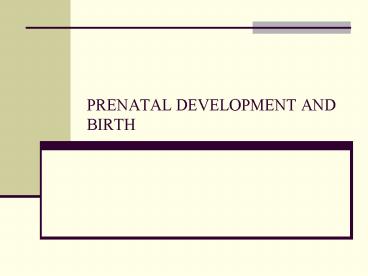PRENATAL DEVELOPMENT AND BIRTH - PowerPoint PPT Presentation
1 / 26
Title: PRENATAL DEVELOPMENT AND BIRTH
1
PRENATAL DEVELOPMENT AND BIRTH
2
Prenatal Development
- Time of fastest development in life span
- Environment extremely important
- Conception
- Ova travels from ovary to uterus
- Penetration by 1 of 300-500 sperm
- Outcome single-celled ZYGOTE
3
Prenatal Stages
- Germinal period days 1-14
- Implantation 1/2 are successful
- Miscarriage 15 (recognized) to 50
- Embryonic period 3rd to 8th week
- Organogenesis, Sexual differentiation
- Fetal period 9th week birth
- Proliferation, migration
- Differentiation of stem cells
- Ends in tremendous brain development
4
Prenatal Environment
- Reciprocal influence
- Person and environment
- Good and bad influences important
- Teratogen Environmental agent
- Harms the developing fetus
- Critical Period Organogenesis
- Dosage and duration
- Genetic make-up Susceptibility
5
- The critical periods of prenatal development.
Teratogens are more likely to produce major
structural abnormalities during the third through
the eighth prenatal week. Note, however, that
many organs and body parts remain sensitive to
teratogenic agents throughout the nine-month
prenatal period
6
Teratogens Drugs
- Thalidomide (for morning sickness)
- All or parts of limbs missing
- Tobacco Miscarriage, low birth weight, SIDS,
slows fetal growth - Alcohol FAS
- Small, facial deformities, retardation
- Cocaine Processing difficulties
7
(No Transcript)
8
- (A) Characteristic features of a child with fetal
alcohol syndrome (FAS).
9
- (B) Child with FAS, illustrating many features in
the drawing. Such children may also have
cardiovascular and limb defects.
10
Teratogens - Diseases
- Rubella (German Measles)
- Blind, deaf, heart, brain
- Syphilis Miscarriage, blind, deaf, heart, brain
- After 18th week
- AIDS Mothers transmit to babies (15-35)
- Prenatally, perinatally, postnatally
11
(No Transcript)
12
(No Transcript)
13
Teratogens Environmental Hazards
- Radiation MR, leukemia, cancer, mutations,
spontaneous abortions, etc. - Avoid X-rays when pregnant
- Pollutants
- In air and water
- Lead MR (also postnatally)
14
The Mothers State
- Age Typically age 16-35
- 15 or younger dont seek prenatal care
- Birth complications, low birth weight
- Over 35Miscarriage, Down Syndrome (fathers age
also) - Emotion Stress can stunt fetal growth
- Positive outlook most helpful
- Nutrition 25-35 lb weight gain
- Malnutrition Smaller neurons, brain, child
15
The Fathers State
- Research limited except for genetic contribution
- Fathers age can also be influential
- Over 35 Increased number miscarriages, heart
defects, Down Syndrome - Over 50 Higher risk for schizophrenia
- Exposure to environmental toxins
- Radiation, anesthetic gases, pesticides
- Damage to genetic material in sperm
16
Postnatal Depression
- Baby Blues mild, common
- Clinical depression 1/10
- Previous depression common
- Children of Depressed Mothers
- Insecurely attached, less responsive
- Negative to other children
17
The Fathers Experience
- Accepted, expected in delivery rooms
- Attend prenatal classes with wife
- Experience described as a significant event
- Anxiety, stress common during delivery
- Relief, pride, joy when baby is born
- Sometimes depression following birth
- Disappointed if sex does not resume soon
18
The Neonatal Environment
- Culture, early socialization, health status
- E.g., low birth-weight babies (8 in US)
- Less than 5½ lbs
- Strongly linked to low SES
- Environment Neonatal intensive care
- Risk Blindness, deafness, CP, autism, cognitive,
and later academic problems - Parenting must be attentive, responsive
19
- Modern technology permits survival of younger and
smaller babies, but many experts believe we have
reached the lowest limits of viability at 23-24
weeks gestation.
20
Learning Objectives
- What are the advantages of breast feeding?
- Are there disadvantages of breast feeding?
- How can at-risk newborns be identified?
- What treatments are available to optimize
development of at-risk babies? - To what extent are the effects of the prenatal
and perinatal environments long lasting? - What factors influence whether effects are
lasting?
21
Breast or Bottle?
- Breast feeding most natural nutrition
- Practices vary across cultures
- Health benefits great for breast-fed infants
- At least first 6 months recommended
- More likely to bottle feed Factors
- Younger, low SES, less education, employed,
African American - US values toward breast feeding ambivalent
22
(No Transcript)
23
Low Birth-Weight Babies
- lt 5½ pounds Small for date or preterm
- Leading cause of infant mortality
- 8 of all births, 65 of all infant deaths
- Factors Low SES, smoking, stress, multiples
- Worse for minority, poverty, single-parent
children - For most, significant catch-up growth
- Low Birth-Weight Infants
- Greater risk for blindness, deafness, CP, autism,
health problems - especially respiratory problems
24
Factors Helpful for LBW Infants
- Breastfeeding, skin-to-skin contact, massage
- Responsive parenting, intellectual stimulation
- Early intervention programs work with parents
- Childcare education and support
- Growth-enhancing home environment
- Consistently attentive, responsive parenting
25
(No Transcript)
26
Risk and Resilience
- Not all high-risk infants have problems
- Werner Kauai Longitudinal study (40 yrs)
- Findings
- Effects decrease over time
- Outcomes depend on postnatal environment
- Protective factors
- Personal resources
- Supportive postnatal environment

